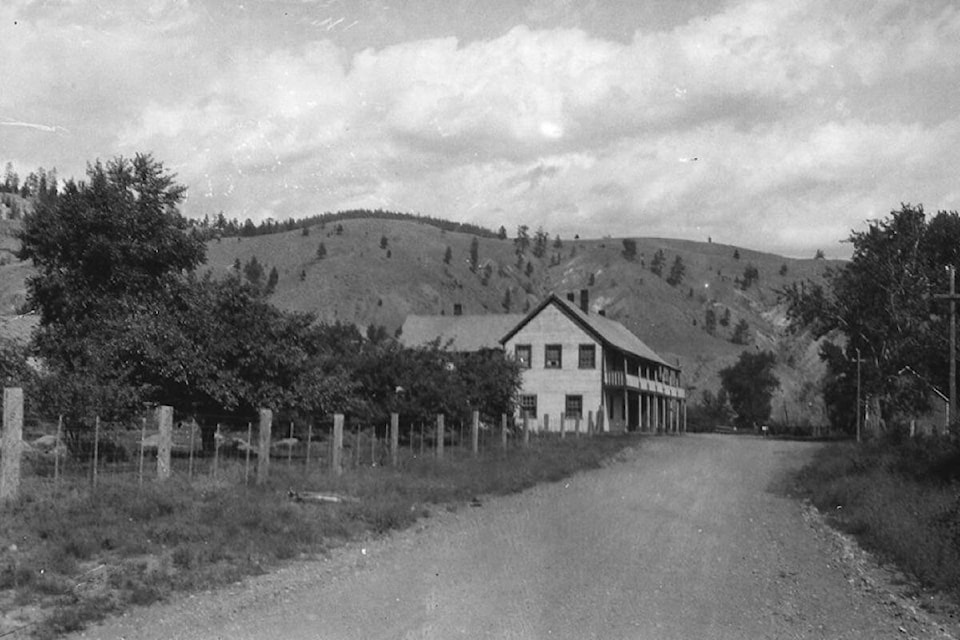While it might seem that summer is over, fall doesn’t start for another two weeks, so there’s still time for a bit more travel while the weather is good. Many people don’t want to travel too far from home, so it’s fortunate that we have a lot of places full of history that can comfortably be visited during a day trip.
The Clinton Museum is still open, and if you haven’t visited for a while you’ll notice a few changes. The museum was built in 1892 of local brick which was provided by a short-lived business in the area, and is the only surviving brick building in the town.
It was originally a schoolhouse, and was also used as a courtroom when need arose (with school cancelled when court was in session). It became a museum in 1956, and houses a large collection of artifacts and documents, records and photographs, about Clinton and the surrounding area going back to the Gold Rush days. Further exhibits are in the former livery stable behind the museum, and there are also numerous historic wooden vehicles on the museum grounds.
Historic Hat Creek almost certainly needs no introduction. It’s one of the few surviving examples of the roadhouses which were spread along the Cariboo Wagon Road, providing food, drink, and accommodation (for people and their horses), and has been beautifully restored and preserved. Stepping back into the roadhouse, where interpreters in period costume regale you with stories of the property and some of the larger-than-life people who lived there, is like stepping back into the 1860s. Once you have toured the roadhouse, take a tour of the grounds, which contain other historic buildings, including a blacksmith shop, where you can watch the smithy at work (and maybe try your hand at pounding a horseshoe). Keep an eye out for the resident chickens, pigs, and sheep.
Take a detour into Ashcroft and visit the museum, constructed in 1917 as a public building which originally housed the post office, telegraph office, Customs agent, and telephone exchange. There are fascinating exhibits that allow you to walk through Ashcroft’s past, and don’t miss the mining display on the second floor.
The historic Chinese cemetery to the east of town beside Highway 97C has been lovingly restored, and now contains beautiful glass mosaics, an altar, and decorative headstones on the graves of those buried there. A large display board describes Ashcroft’s once-thriving Chinatown and the importance of Chinese immigrants to the province and area.
Ancient burial sites, and preserved cave paintings, are at the summit of Savona Mountain, which overlooks Kamloops Lake. The caves were not used for burials; the Secwepemc people believed that harmful spirits known as “land mysteries” lived in them. However, remains of burial sites in more open land are evident on the side of the mountain near the summit. The cave paintings were made by “the people of long ago” and are painted in red, the colour of life, good luck, and virtue.
Scattered throughout the area are the features known by First Nations people as “coyote rocks”; the most well-known one is probably the “Balancing Rock” between the top of Six Mile Hill and Savona, to the north of Highway 1. These columns or pillars with a rock balanced atop them are formed when a “cap” rock of hard material sits on top of softer sedimentary rock and silt, which gradually erodes, leaving the harder material perched on top.
According to Secwepemc legend, these markers were created long ago by the Old One (Creator) and his main assistant, Coyote, to mark Secwepemc territory.
The Soldiers Memorial Hall in Walhachin was constructed in 1912, and while it was used as a fruit packing house it also served a more vital function to the town’s residents: a central place for entertainment in the community. Walhachin was becoming known at that time for its large gatherings, and the hall – with its spruce-planked floating dance floor set on springs – was very popular with residents and guests.
The name was bestowed on the hall after World War I, which saw 97 of the 117 men living in Walhachin at the time enlist; few of them returned. A cenotaph behind the hall now commemorates these men, and the hall itself contains a museum which explores the short but eventful life of Walhachin, the not-quite-ghost-town.
The Packing House in Spences Bridge is now a popular restaurant, but it started life more than 100 years ago as exactly what the name says: a packing house for the fruit (mainly apples) produced by Jessie Smith, better known as Widow Smith of Spences Bridge, whose apples were specifically requested by King Edward VII of England at the Royal Horticultural Fair in London.
The apples from Mrs. Smith’s orchards were carefully graded and sorted, with any long stems trimmed so they would not cause bruising (one bruised apple could ruin an entire box); then each apple was carefully wrapped in cotton batting and placed in a wooden packing box, for shipment all over the world. Today, diners can enjoy a delicious meal or snack inside a unique piece of B.C.’s history.
Happy travels!
editorial@accjournal.ca
Like us on Facebook and follow us on Twitter
